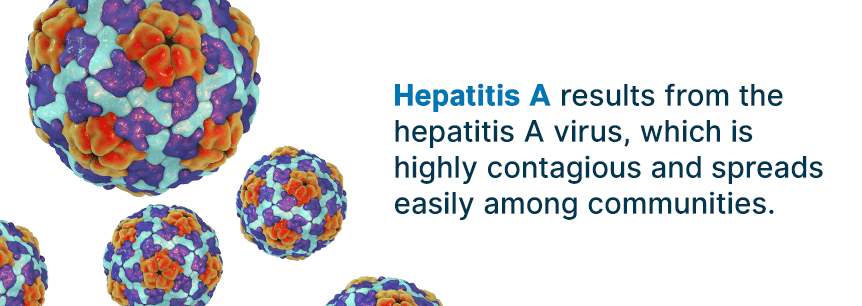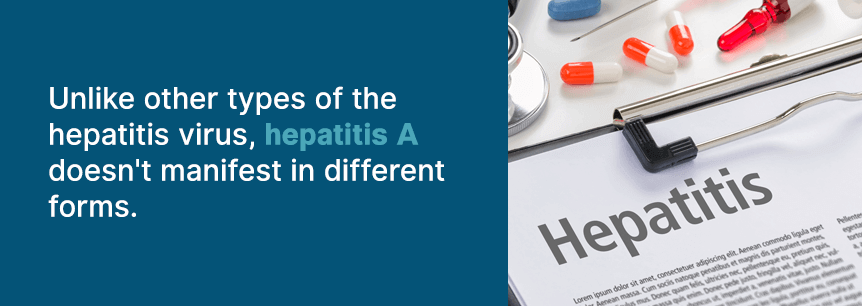
A diagnosis of hepatitis A is often simultaneously relieving and discouraging. While it is not as severe as other types of hepatitis, hepatitis A still comes with a list of unpleasant symptoms that can make daily life difficult.
Medical marijuana can be an effective alternative treatment for hepatitis A. Before we go into the specific ways medical marijuana treats hepatitis A, let’s examine the details of the virus, including its causes, symptoms, and complications.
Hepatitis A virus (HAV) is a highly contagious liver infection caused by one of several types of viral hepatitis. There are three categories of the hepatitis virus: A, B, and C. Of all these forms of hepatitis, hepatitis A is considered the mildest type of the virus.
In most cases, the symptoms of hepatitis A disappear after a few months. Many patients recover fully and develop lifelong immunity to the virus. A vaccine is now available for the virus, and it has significantly reduced the number of cases worldwide — however, according to the World Health Organization, hepatitis A claimed the lives of 11,000 people worldwide in 2015.
Hepatitis A results from the hepatitis A virus, which is highly contagious and spreads easily among communities. The virus infects the liver cells, resulting in inflammation and a reduced ability to function.

Some of the ways hepatitis A can spread include the following:
Most of the time, an outbreak of hepatitis A is the result of consuming food or water polluted with fecal matter, even if it’s just trace amounts. Although hepatitis A is contagious, it isn’t an airborne virus — it can’t spread through coughing or sneezing.
Sporadically, HAV will occur in epidemics across the world. The virus tends toward cyclic recurrences, and viral hepatitis is one of the most common causes of food-related infection. Around the world, communities tend to share food and water systems, which means hepatitis epidemics can erupt without warning and infect vast numbers of people.
Viral hepatitis can persist in the environment and can survive even when exposed to modern food-production processes. Epidemics of the virus can have significant social and economic repercussions within a community, since those infected often require several weeks or months to recover.
Not everyone is at a high risk of contracting hepatitis A — certain lifestyles and regions of the world are more prone to outbreaks of viral hepatitis than others.
However, you could become infected with hepatitis A if you:
While none of these factors guarantee a hepatitis infection, if one or more applies to your lifestyle, you are at an increased risk of contracting the virus. Preventive measures mainly revolve around practicing good hygiene — wash your hands frequently and thoroughly, and avoid sharing food and water when possible.
While not as severe as other forms of viral hepatitis, HAV still comes with many negative, flu-like symptoms. Some of the most common symptoms include the following:
The symptoms of hepatitis A could be relatively mild, and in many cases, they will disappear after a few weeks. However, in rare instances, hepatitis A can develop into a more severe illness.
Unlike other types of the hepatitis virus, hepatitis A doesn’t manifest in different forms. However, in rare cases, hepatitis A can result in a sudden loss of liver function, called acute liver failure, fulminant hepatic failure or fulminant hepatitis.

Older adults or patients with chronic liver diseases are most at risk for developing fulminant hepatitis from HAV. Liver failure requires a stay in the hospital so physicians can monitor and treat the condition. In some cases, fulminant hepatitis patients need a liver transplant, and the disease is often fatal.
Mild cases of hepatitis A often don’t require treatment — for many patients, their immune systems fight off the infection without help within six months, and they recover without permanent liver damage. The most common “treatments” involve rest and nausea management.
In more severe cases, doctors prescribe their patients with HAV a variety of medications. Pain relievers, antihistamines, and antiemetic drugs are common, including over-the-counter painkillers such as ibuprofen. Prescribed antiemetic medications such as metoclopramide can also be helpful for patients with HAV.
However, these medications come with a long list of adverse side effects, including fatigue, diarrhea, headache, insomnia, muscle stiffness, and depression — they can exacerbate the existing symptoms of hepatitis A. In some cases, antiemetic drugs can even increase vomiting, negating their anti-nausea effects.
Now that we’ve examined hepatitis A and its causes, symptoms, and complications, we can explore marijuana as an alternative treatment. First, let’s go into the science behind how marijuana works in our bodies.
As cannabis enters the bloodstream, it begins to interact with the body’s existing endocannabinoid system (ECS). The ECS is a recently discovered system that plays a vital role in maintaining homeostasis throughout the body. A multifaceted system, the ECS assists with many crucial functions, including memory, metabolism, appetite regulation, immune response, and intercellular communication.
The ECS has two different types of receptors, CB1 and CB2, scattered throughout the body. Primarily, CB1 receptors are around the brain and spinal cord, as well as in various glands, organs, and connective tissues. In contrast, CB2 receptors are mainly in the peripheral nervous system and the immune system.
When cannabis enters the body, its chemical compounds bind to either CB1 or CB2 receptors — the specific receptor the marijuana targets will determine its effects.
The different chemical compounds making up marijuana are called cannabinoids. Researchers have discovered as many as 85 different cannabinoids within the cannabis plant, but the primary cannabinoids are tetrahydrocannabinol (THC) and cannabidiol (CBD). The main difference between the two cannabinoids is which ECS receptors they target — while THC binds to CB1 receptors, CBD primarily attaches to CB2 receptors.
Because THC interacts with the ECS receptors centered in the brain and nervous system, it is the cannabinoid associated with the psychoactive “high” of marijuana. Alternately, CBD doesn’t cause a psychoactive sensation — since it binds to the receptors in the immune system, CBD provides the therapeutic benefits of cannabis without the high.
While recreational users often enjoy marijuana strains high in THC, many medical marijuana users prefer CBD-high strains. When searching for the right strain for your specific condition and needs, research the ratios of different cannabinoids within the plant. The primary cannabis strains are Indica and Sativa, and each is dominant in a different cannabinoid — Indica strains have high amounts of CBD, and Sativa strains contain a high ration of THC.
Medical marijuana shows promise for treating all forms of viral hepatitis.
According to one study, the consumption of cannabis slowed the process of viral hepatitis throughout the body. For patients with hepatitis B, a recent study showed marijuana enhanced fibrogenesis, helping heal and repair wounded body tissue.

Due to the legal complications surrounding marijuana, it has been difficult for researchers to acquire study permits for cannabis. Because of this, research concerning cannabis and HAV is incomplete and still in progress. However, what we know points to cannabis helping the ECS fight off the hepatitis infection.
In addition to helping the body heal from the hepatitis virus, cannabis can help reduce its most common symptoms.
Hepatitis A commonly results in joint and abdominal pain. The pain is a result of the inflammation surrounding the liver and joints, which can lead to severe discomfort.
Cannabis is renowned for its pain-relieving effects. Marijuana has successfully reduced joint pain in a wide variety of conditions, including osteoarthritis, rheumatoid arthritis, tendinitis, bursitis, and lupus. In one 2016 study, topical cannabis products high in CBD were successful in decreasing pain and inflammation due to arthritis. Another 2017 study revealed CBD effectively and safely treated joint pain in patients with osteoarthritis, proving cannabis has powerful pain- and inflammation-relieving properties.
Some of the best strains of marijuana to reduce pain and inflammation include:
Loss of appetite is a common symptom of viral hepatitis. Medical marijuana has proven to be a holistic way to increase the appetite healthfully and naturally, without the side effects of typical pharmaceuticals.
In one study, using cannabis increased a patient’s caloric intake by 40 percent. THC, in particular, can cause an appetite increase, and it can help maintain a patient’s weight as they recover from HAV.
To increase appetite, try one of the following marijuana strains:
For patients with HAV, severe nausea and vomiting are common symptoms. Medical marijuana can help reduce sensations of nausea — the endocannabinoid system helps regulate nausea in the body, and since cannabinoids interact with the ECS, they can help the endocannabinoid system repress sensations of sickness.
According to a 2011 study, CBD has shown its effectiveness as an antiemetic medication — it lowered vomiting and nausea in animal studies, and it has helped cancer patients reduce vomiting related to chemotherapy.
To reduce nausea, try one of these strains of cannabis.
Cannabis is a naturally occurring medicine, a holistic alternative to many of the typical pharmaceutical treatments for hepatitis A. But just as with any medication, marijuana carries the risk of some negative side effects.

Just like any medication, marijuana will affect every person differently. For the best, safest results, work with a certified marijuana doctor as you experiment with different strains and methods — they can monitor your progress and help you determine which type of cannabis is right for you.
Smoking a joint isn’t the only way to consume marijuana. Cannabis products come in a wide array of types, including soothing creams, precise tinctures, and tasty edibles.
For hepatitis A, here are some of the most accessible methods to consume cannabis.
Even if you have used marijuana products before, experiment with some new methods — you might discover a new favorite way to use cannabis, or you could find one method works better for you than others.
If you want to pursue medical marijuana as an alternative treatment for hepatitis A, MarijuanaDoctors.com is here to help.

We have all the information and resources you need to begin your journey. Browse our extensive online directories of certified marijuana doctors and dispensaries to find experts near you. Let medical cannabis help you regain your health — search for a qualified dispensary and physician today.
Find A Doctor Find A Dispensary